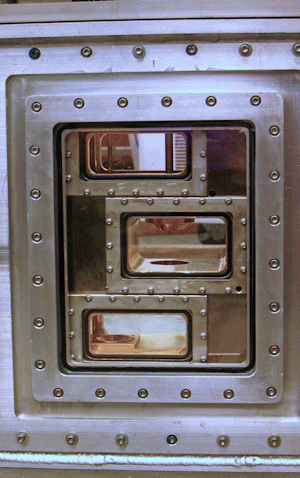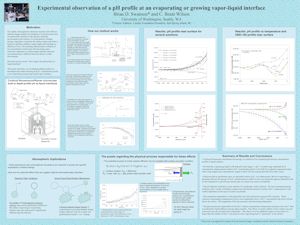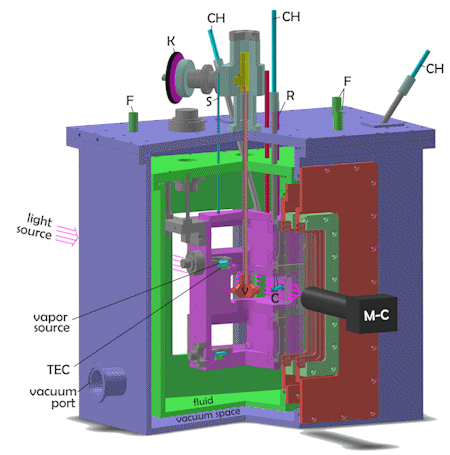New Projects at LF Research
Growth and Sublimation rates and Ice particle habit Evolution
We study the growth, sublimation and light scattering properties of tropospheric ice particles. One of the instruments we use is a low temperature electrodynamic balance which allows us to observe single ice particles away from the influence of surfaces. Our work focuses measuring growth rates, particle shape evolution and the influence of ice nucleation mode on ice particles grown in the laboratory under conditions similar to those observed in cold clouds. We have developed, in collaboration with Jon Nelson, a new three capillary instrument to study ice crystal growth. The new instrument will provide much more precise temperature, supersaturation and nucleation mode control than has been available in previously used methods.

Close up of new ice chamber apparatus
|
Ions and pH near the solution-air and ice-air interface
We have been interested in the microphysics of ions and molecules that reside near an air-water or air-ice interface. We have built a cryostat and integral confocal microscope to measure the ion and pH profile near these interfaces. This instrument is also useful for fluorescence microscopy and resonant Raman spectroscopy studies of molecules at interfaces. Our goal is a better understanding of the microphysics of charge transfer between colliding particles which is thought to be responsible for the electrification in thunderstorms.
Results for pH Profile Experiment

|
|
What's New at Laucks Foundation Research
NEW EXPERIMENTAL ICE GROWTH CHAMBER
|
We have developed a new instrument for the study of low-temperature ice growth/sublimation rates and habit development. In the new design we have incorporated several improvements over previously used devices. The new design will speed up data-taking, improve data quality and reproducibility, and increase the temperature, pressure and humidity stability of the experimental chamber.
|

Photo of new ice chamber apparatus
|

Schematic drawing of ice chamber
|
The new design has two chambers connected to the growth chamber by a valve (marked V in the schematic). The humidity in each chamber is set by a TEC-controlled vapor source (colored blue in the schematic). The valve exposes the ice crystals to one vapor source chamber (with a particular humidity) while isolating the ice crystals from the other vapor source chamber (with a second humidity). This eliminates the wait while switching between either two different growth conditions or, more commonly, growth and sublimation. Growth and sublimation cycling are important in the proposed experiments to ensure that growth rate results are repeatable for a particular crystal size. (A size and shape-dependent growth rate has not been
carefully considered in previous measurements.) This design feature will hasten data-collection and changes in condition. The valve operates via a rotary magnetic-fluid feed-through and is designed to give minimal changes in air pressure - less than 0.1%.
Other additions are:
1) A single-block (high thermal conductivity and high volumetric heat capacity) tellurium-copper experimental chamber to minimize thermal gradients and vapor-flow impedances.
2) A gold-plated experimental chamber interior to reduce potential chemical contamination.
3) A reference vapor pressure chamber that allows the use of a differential-pressure measurement system to assist with the precise calibration of the TEC temperature/vapor pressure relationship of each vapor-source.
4) Three capillaries to monitor habit variation, crystal-crystal proximity and crystal-window proximity effects.
5) A double-walled vacuum shroud, surrounding the bath box, to minimize heat loading and temperature gradients for experiments below -40°C.
The design is engineered to have negligibly small thermal gradients near the crystal - for vapor-source temperature deviations of 10°C above or below ambient wall temperature the gradient is expected to be less than 0.01°C/cm. To monitor temperature gradients, the experimental chamber has 12 built-in thermistors. Experiments can be done under
isothermal conditions (w/o current to the TECs) by changing the solute concentration in the vapor sources using the two vertical vapor source access tubes and a long syringe.
The use of a single block for the experimental chamber allowed us to locate the source chambers close to the growth chamber. The vapor-flow impedance is engineered to remain below 10 s/m3 - much less than the threshold of 500 s/m3 (the threshold predicted crystal).
With the double-walled vacuum shroud, the main heat loads to the experimental chamber are through the tubes and the windows in front and back. By optimizing the tube diameters and vacuum gap distance, the total heat load at -40°C should be below 100 W, well within the cooling power of the ULT-80 circulating cooler. The chamber tube diameters were engineered to minimize heat loads while keeping reasonable throughput so pump-down times will be less than 30 minutes. The chamber was also designed to have rapid response times (about 2 min or less for intermediate changes in humidity) when heating the vapor sources using the TECs.
|

